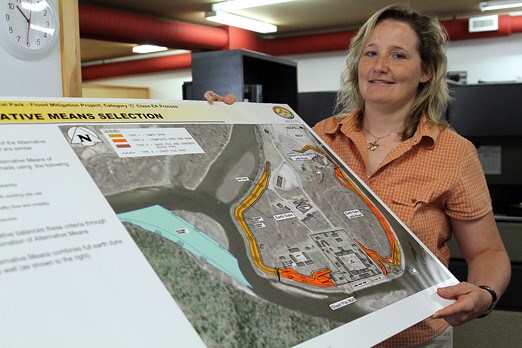A flood-prone Fort William Historical Park is about to build up its defences.
A three-metre-high, two-kilometre dike will be built around the provincial park, starting next spring in hopes of warding off the surging waters of the Kaministiquia River.
Over the past decade the facility has faced several flood and near-flood situations, says Robin Gould, a project manager for ANC-Lavalin O&M, who are co-ordinating engineering firm KGS’s efforts to conduct an environmental assessment and project engineering to come up with an efficient, yet effective solution to the ongoing problem.
A public open house was held earlier this week, says project manager Robin Gould, who FWHP deferred comment to on the matter.
Several alternatives, including moving the Fort to other nearby property or raising it above flood-water levels, were tossed around, but in the end a reinforced earthen dike system made the most sense,” Gould said.
A sheet pile wall will also be incorporated into the design along the water’s edge, to protect the grounds, but still maintain access to the river, where several major Fort events are centred.
“The earthen dike portion will blend in very well with the natural aesthetics of the Fort itself. The earthen dike will probably be a three-metre-high swale in the landscaping. That’s a natural topography for the area, so when it’s done and the earthen dike is there and revegetated, when you’re paddling down the river and you approach the Fort facility, you won’t notice it,” Gould said.
The sheet-pile wall will have a like-minded treatment, she added.
“What we’re looking at, at the palisade section, is a vertical steel wall which would be basically hidden behind the palisade,” she said.
“We’ll put the sheet-pile wall in and then put some planking on each side. To the visitor it would have no visual impact and that’s a major concern of the fort, so we don’t upset the historical presence on the site.”
Gould isn’t sure how much the project will cost, saying it’s too preliminary in the process to determine that just yet. But she did say the dike system involved moving about half the amount of material as the other two solutions considered.
The earthen dike system also comes with a proposal to cut a channel into the river bend adjacent to the Fort, to allow ice to flow more smoothly through the water and not get trapped, a major cause of recent flooding.
In 2007, the province spent $2.3 million to repair damage from a 2006 flood, about 20 per cent of its overall facilities rehabilitation budget.
Major floods also occurred in 1977, 2003 and 2008. Minor flooding also occurred earlier this year.
According to government figures, FWHP attracts 90,000 people each year to the Thunder Bay area and generates an annual economic impact of more than $8 million.
